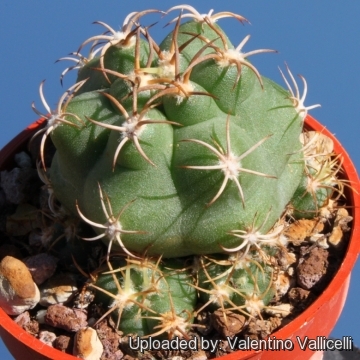
Matucana madisoniorum var. pujupatii Photo by: Valentino Vallicelli
Origin and Habitat: Cajamarca (San Martin) - Peru (South America) Matucana pujupatiiSN|2247]]SN|2247]] is reported from a very small area (extent of occurrence less than 100 km2) It is only known from the type locality
Altitude: It is found at an altitude of 400-500 meters above sea level.
Habitat: The species is found in dry forest.
Synonyms:
See all synonyms of Matucana madisoniorum
back
Accepted name in llifle Database:Matucana madisoniorum var. pujupatii (Donald & A.B.Lau) G.D.RowleyRepert. Pl. Succ. (I.O.S.) (Regnum Veg., 87): 10 (1973)Synonymy: 3
Accepted name in llifle Database:Matucana madisoniorum (Hutchison) G.D.RowleyRepert. Pl. Succ. (I.O.S.) (Regnum Veg., 87): 10 (1973), without basionym pageSynonymy: 13
back
Description: Matucana pujupatiiSN|2238]]SN|2247]] was firstly described as a variety of Matucana madisoniorumSN|2238]]SN|2238]] but some authors considers this plant sufficiently distinct to deserve it a species rank on its own. Its appearance is very much like that of Matucana madisoniorumSN|2247]]SN|2238]] but shows more a cylindrical body shape with more pronounced tubercled ribs, does not really show the very fine hairs for that velvet appearance and its flowers are a very bright red with a very obvious fluorescent sheen. This plant also offsets quite readily.
Habit: Plants sometimes basally branching weakly. Offsets are produced from the base of the main stem. Usually starting just below soil level.
Stems: Globose to to elongate, green, grey-green to blue-green, to 15(-30) cm high and
10 cm in diameter.
Ribs: 10-12, straight, broad, noticeably tuberculate.
Spines: Brown with yellowish bases, becoming grey with age, more or less flexible.
Central spines: 1-2 (often lacking), to 50 mm long.
Radial spines: 6-9, 5-20 mm long curved inward.
Flowers: Forming at the apex from new areoles, slightly zygomorphic, tending to lean on one side, slightly curved, carmine red, 6-7 cm long, 4-5 cm in diameter.
Blooming time: Flowers more than once in several flushes throughout the summer.
Fruits: Globose to oval, purplish green, to 10 mm in diameter.
Bibliography: Major references and further lectures
1)Edward Anderson “The Cactus family” Timber Press, Incorporated, 2001
2) James Cullen, Sabina G. Knees, H. Suzanne Cubey "The European Garden Flora Flowering Plants: A Manual for the Identification of Plants Cultivated in Europe, Both Out-of-Doors and Under Glass" Cambridge University Press, 11/Aug/2011
3) David R Hunt; Nigel P Taylor; Graham Charles; International Cactaceae Systematics Group. "The New Cactus Lexicon" dh books, 2006
4) Ostalaza, C. & Roque, J. 2013. Matucana pujupatii. In: IUCN 2013. "IUCN Red List of Threatened Species." Version 2013.1. <www.iucnredlist.org>. Downloaded on 30 October 2013.
5) Rob Bregman “The Genus Matucana: Biology and Systematics of Fascinating Peruvian Cacti” A.A. Balkema, 1996
6) Urs Eggli, Leonard E. Newton: "Etymological Dictionary of Succulent Plant Names." Springer, Berlin/Heidelberg 2010
7) National Cactus and Succulent Journal. volume 26, Nummer 3, page 71, 1971
8) Rob Bregman: "Note on the Genus Matucana (Cactaceae)." In: Willdenowia. volume 17, Number 1–2, page 179 1988
 Matucana madisoniorum var. pujupatii Photo by: Valentino Vallicelli
Matucana madisoniorum var. pujupatii Photo by: Valentino VallicelliSend a photo of this plant.The gallery now contains thousands of pictures, however it is possible to do even more. We are, of course, seeking photos of species not yet shown in the gallery but not only that, we are also looking for better pictures than those already present.
Read More... Cultivation and Propagation: Matucana pujupatiiSN|2247]]SN|2247]] grow slowly in their natural habitats, but in greenhouses they grow quickly with tissue that is less firm.
Hardiness: Not very hard to grow if protected from freezing temperature they needs care in cultivation to reach a good size without developing unsightly marks, need a minimum temperature of 10° C, but may survive a light frost.
Exposure: They benefit from a good light but not severe sunlight.
Soil: Grow it in rich, porous soil.
Repotting: Repot in the spring when their roots become cramped. Generally, they should be repotted every other year in order to provide fresh soil. However, this doesn't necessarily mean they'll need larger containers. After repotting, do not water for a week or more.
Waterings: Water sparingly from March till October, the thin, fibrous roots suffer if there is humidity, therefore the plant should be watered only when the surrounding terrain is dry. Keep dry as soon as the temperature starts dropping in October and keep it perfectly dry in winter at temperatures from 10 to 15 degrees centigrade. Needs good drainage
Propagation: Seeds, cuttings or root suckers (if available). Not too difficult to raise from seed.











